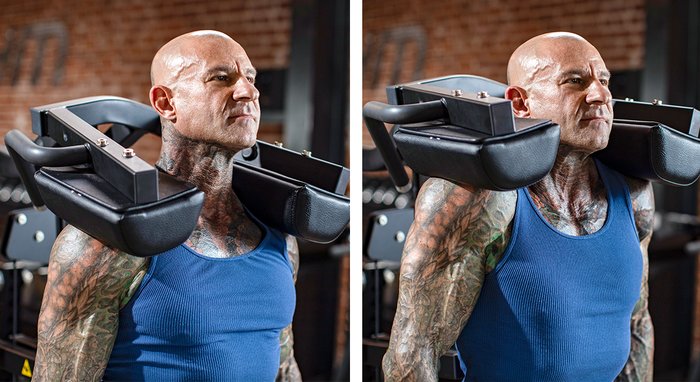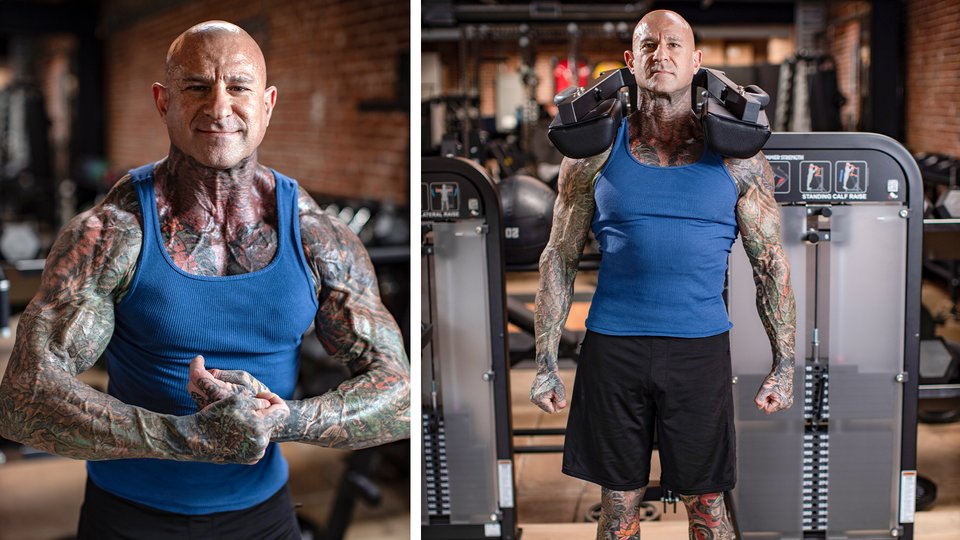Products You May Like
When training for size and strength in the gym, you’re only as strong as your weakest link. When shrugging, that weak link is usually your hands.
Think about it: How many times have you had to end a set of heavy shrugs because you couldn’t hang on to those 70-, 80-, or 100-pound dumbbells? When this happens, your hands and forearm muscles get a great workout, but your upper traps—the muscle group you’re actually trying to target by doing shrugs—not so much.
So, how do you fully fatigue your traps on every set of shrugs? Take your hands completely out of the movement with “hands free” standing calf machine shrugs.
As the name of the exercise implies, you’ll be hitting your upper traps on an apparatus intended for calf training. One of my favorite ways to get creative in the gym is to use machines for different purposes. Think back to that set of dumbbell shrugs with the 100s where your hands gave out. Now you can pile on 200 pounds with the calf raise machine and not have to worry about your grip.
The shrug is a single-joint movement, so you want to reduce the involvement of other muscle groups—your hands, forearms, delts, and lower body—as much as possible. Granted, a number of multijoint exercises are good for upper trap development, namely upright rows as well as Olympic movements like high pulls and cleans. But when you’re training the traps in a traditional bodybuilding-style program, isolation is the key. Standing calf machine shrugs isolate the upper traps as well as any exercise.
How to Perform Standing Calf Machine Shrugs

- Load a standing calf raise machine with a relatively heavy weight. Your upper traps can usually handle a decent amount of weight, partly because shrugs have such a short range of motion. That said, if you’re new to the exercise, err on the light side and add weight if it’s too easy.
- Place the tops of your shoulders squarely underneath the machine pads and step onto the foot platform. If you were doing calf raises, you’d want to make sure only the balls of your feet were on the platform, but foot position isn’t nearly as important for shrugs. Find whatever position provides a comfortable, stable base.
- Bend your knees slightly to take pressure off your lower back. With your head facing forward and your arms hanging straight down, let your shoulders drop down (depression) to where you can feel a stretch in your upper traps. Then, shrug your shoulders up (elevation) as high as possible and hold the top position for a 1-second count. Slowly lower your shoulders back down and repeat for reps.
Training Tip: The range of motion on shrugs is short, but it shouldn’t be too short. If you’re barely able to lift your shoulders to where they’re approaching your chin, it probably means you’re going too heavy and need to lighten the load.
Sets, Reps, and Rest: Like abs and calves, the traps typically respond a bit better to higher rep counts, so shoot for 3-4 sets of 15-20 reps on calf raise machine shrugs. Standard rep ranges of 8-12 with slightly heavier weight are also effective for building bigger upper traps. When you’re in a heavy training phase, you can even drop to sets of 6-8 reps on shrugs.
When to Do These: The most common time to train the upper traps is on shoulder day, after hitting your delts with overhead presses, lateral raises, or upright rows—your typical shoulders and traps workout. You can do calf raise machine shrugs as either the first or last exercise for traps.
Inspired by Stoppani’s creative workout tactics and ready to put on more size his way? Build your traps and beyond in 12 weeks with Jim Stoppani’s Shortcut to Size, available only on Bodybuilding.com All Access.
